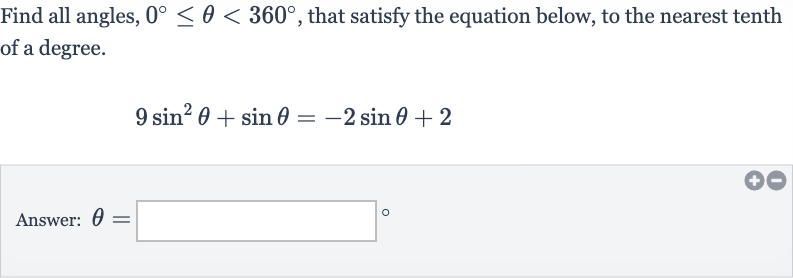Full solution
Q. Find all angles, , that satisfy the equation below, to the nearest tenth of a degree.Answer:
- Simplify Equation: Simplify the given equation by moving all terms to one side to set the equation to zero.Add to both sides and subtract from both sides to get:
- Factor Quadratic Equation: Factor the quadratic equation in terms of . We are looking for two numbers that multiply to and add up to . These numbers are and . So we can write the equation as:
- Solve First Factor: Solve each factor for .First factor: Add to both sides:Divide by :
- Solve Second Factor: Solve the second factor for .Second factor: Subtract from both sides:Divide by :
- Find Angle for : Find the angles that correspond to . Since is not a standard angle, we will use a calculator to find the inverse sine (arcsin) of . This will give us the principal angle in the first quadrant. We also need to find the angle in the second quadrant where sine is positive.
- Find Angle for : Find the angles that correspond to .Since is also not a standard angle, we will use a calculator to find the inverse sine (arcsin) of .This will give us the principal angle in the fourth quadrant. We also need to find the angle in the third quadrant where sine is negative.
More problems from Csc, sec, and cot of special angles
QuestionGet tutor help
QuestionGet tutor help
QuestionGet tutor help
QuestionGet tutor help
QuestionGet tutor help
QuestionGet tutor help
Question
. Find the value of in degrees.Write your answer in simplified, rationalized form. Do not round.____
Get tutor helpQuestionGet tutor help

